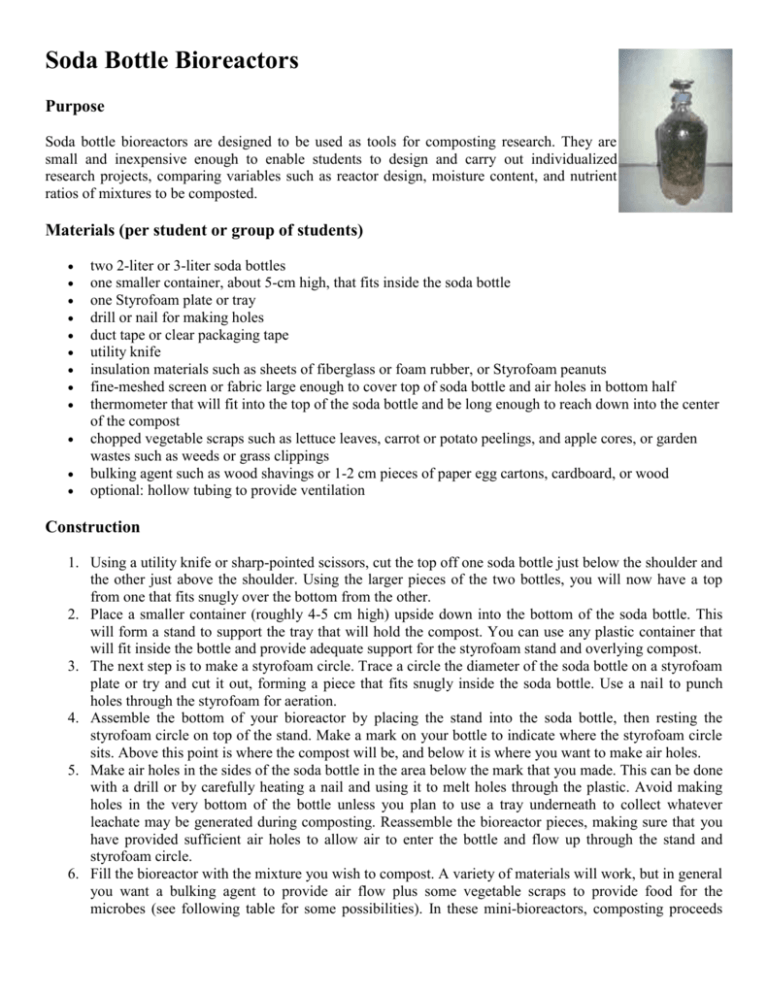Soda Bottle Bioreactors
advertisement

Soda Bottle Bioreactors Purpose Soda bottle bioreactors are designed to be used as tools for composting research. They are small and inexpensive enough to enable students to design and carry out individualized research projects, comparing variables such as reactor design, moisture content, and nutrient ratios of mixtures to be composted. Materials (per student or group of students) two 2-liter or 3-liter soda bottles one smaller container, about 5-cm high, that fits inside the soda bottle one Styrofoam plate or tray drill or nail for making holes duct tape or clear packaging tape utility knife insulation materials such as sheets of fiberglass or foam rubber, or Styrofoam peanuts fine-meshed screen or fabric large enough to cover top of soda bottle and air holes in bottom half thermometer that will fit into the top of the soda bottle and be long enough to reach down into the center of the compost chopped vegetable scraps such as lettuce leaves, carrot or potato peelings, and apple cores, or garden wastes such as weeds or grass clippings bulking agent such as wood shavings or 1-2 cm pieces of paper egg cartons, cardboard, or wood optional: hollow tubing to provide ventilation Construction 1. Using a utility knife or sharp-pointed scissors, cut the top off one soda bottle just below the shoulder and the other just above the shoulder. Using the larger pieces of the two bottles, you will now have a top from one that fits snugly over the bottom from the other. 2. Place a smaller container (roughly 4-5 cm high) upside down into the bottom of the soda bottle. This will form a stand to support the tray that will hold the compost. You can use any plastic container that will fit inside the bottle and provide adequate support for the styrofoam stand and overlying compost. 3. The next step is to make a styrofoam circle. Trace a circle the diameter of the soda bottle on a styrofoam plate or try and cut it out, forming a piece that fits snugly inside the soda bottle. Use a nail to punch holes through the styrofoam for aeration. 4. Assemble the bottom of your bioreactor by placing the stand into the soda bottle, then resting the styrofoam circle on top of the stand. Make a mark on your bottle to indicate where the styrofoam circle sits. Above this point is where the compost will be, and below it is where you want to make air holes. 5. Make air holes in the sides of the soda bottle in the area below the mark that you made. This can be done with a drill or by carefully heating a nail and using it to melt holes through the plastic. Avoid making holes in the very bottom of the bottle unless you plan to use a tray underneath to collect whatever leachate may be generated during composting. Reassemble the bioreactor pieces, making sure that you have provided sufficient air holes to allow air to enter the bottle and flow up through the stand and styrofoam circle. 6. Fill the bioreactor with the mixture you wish to compost. A variety of materials will work, but in general you want a bulking agent to provide air flow plus some vegetable scraps to provide food for the microbes (see following table for some possibilities). In these mini-bioreactors, composting proceeds best if the bulking agent and food scraps are cut or chopped into roughly 1-2 cm pieces. Soak the bulking agent in water until thoroughly moist, and then drain off excess water. Bulking Agents wood shavings Food for the Microbes lettuce scraps small wood chips carrot peelings newspaper strips pieces of paper egg cartons chopped straw apple cores bread crusts banana peels weeds grass clippings 7. Mix roughly equal amounts of bulking agent and food scraps, then fill your reactor. Remember that you want air to be able to diffuse through the pores in the compost, so make sure to keep your mix light and fluffy and do not pack it down. 8. Put the top piece of the soda bottle back on and seal it in place with tape. 9. Cover the top hole with a piece of screen or nylon stocking, rubber banded into place. Alternatively, if you are worried about potential odors you can ventilate your bioreactor using rubber tubing out the top. Simply use the screw-on soda bottle cover with a hole drilled through it for a piece of rubber tubing, which leads out the window or into a ventilation hood. 10. If you want to eliminate the possibility of flies becoming a problem, you can cover all air holes with a piece of nylon stocking or other fine-meshed fabric. 11. Insulate the bioreactor, making sure not to block the ventilation holes. (Because these soda bottle bioreactors are much smaller than the typical compost pile, they will work best if insulated to retain the heat that is generated during decomposition.) You can experiment with various types and amounts of insulation. 11. Now you are ready to watch the compost process at work! You can chart the daily progress of your compost by taking temperature readings, inserting a thermometer down into the compost through the top of the soda bottle. Using temperature charts, you can compare variables such as the types of compostable materials, moisture levels, amounts of air flow, and insulation systems. 12. Because the bottles are so small, you may not end up with a product that looks as finished as the compost from larger piles or bioreactors. You should find, though, that the volume shrinks by 1/2 to 2/3 and that the original materials are no longer recognizable. You can let the compost age in the soda bottles for several months, or transfer it to other containers for curing while starting up a new batch of compost in the soda bottles.








